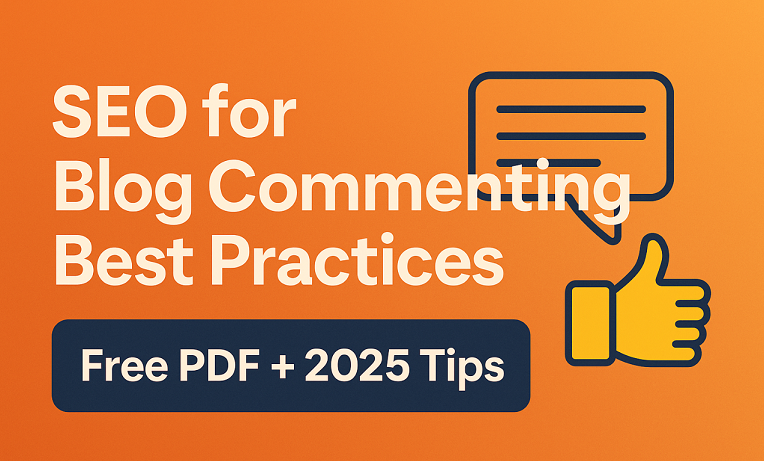🎯 SEO for Blog Commenting Best Practices: The 2025 Edition You Didn’t Know You Needed!
Ah, blog commenting. That humble section at the end of a blog post. Some treat it like the VIP lounge of content marketing, others like a dusty storage room. But here’s the truth: when used right, blog commenting is an SEO goldmine. And today, we’re diving into the SEO for blog commenting best practices — including tips for 2025, a free downloadable PDF, and even some juicy secrets the “gurus” won’t tell you.
So buckle up, SEO explorers — it’s going to be a wild (and witty) ride.
💡 First, what is blog commenting in SEO?
Imagine you’re at a party (online), and instead of just lurking in the corner, you join the conversation. That’s what blog commenting is. You’re engaging with someone else’s content — leaving relevant, helpful, or even humorous insights — and if you play your cards right, earning traffic and authority for your own blog.
Blog commenting in SEO isn’t about dumping your link and disappearing. It’s about relationship-building and value-packed engagement. Google loves genuine interactions. Your future readers do, too.
🧠 Why Is Blog Commenting Good for SEO?
Glad you asked.
-
✅ Build backlinks (the right way)
-
✅ Drive referral traffic
-
✅ Build relationships with niche influencers
-
✅ Boost brand visibility
-
✅ Show search engines you’re alive and relevant
Still asking, “Is blog commenting good for SEO?” Absolutely. But only if done with intent. Let’s learn how.
📚 SEO for Blog Commenting Best Practices (Updated for 2025!)
Here’s your ultimate guide (also available as a free downloadable PDF — no strings attached).
1. Find the Right Blog Commenting Sites
Don’t just throw your thoughts anywhere. Use high-DA, niche-relevant, and active sites. Check out any free blog commenting website lists, or just search “your niche + blog commenting sites.”
Bonus Tip: Check out their blog comment examples before you jump in — are they high quality or spammy? That’s your clue.
2. Avoid the “Nice Post” Curse
If you’re just saying “Great article!”—stop. That’s the SEO equivalent of ghosting your gym membership.
Instead, try:
“This strategy you shared for optimizing blog headlines really resonated with me. I recently tried something similar using emotional triggers and saw a 22% bump in engagement. Have you tested those yet?”
Now THAT’s a blog commenting tutorial in action.
3. Use Your Real Name & Photo
Don’t comment as “BuyBacklinks123.” Be human. Be authentic. Be memorable.
4. Link Smartly (if at all)
You don’t need to drop a link every time. If the comment section allows links, and it adds real value, go ahead. Otherwise, use your name field or profile link.
No link bombs. Just a 👑 classy presence.
5. Be Early, Be Consistent
Top comments get the most visibility. Set up Google Alerts in your niche. Jump into new posts fast — and stay consistent. Make it part of your SEO blog content writing schedule.
6. Download the PDF: SEO for Blog Commenting Best Practices Free
Want to keep all this handy? Download the full SEO for blog commenting best practices PDF right here. (Insert lead magnet link or CTA.)
🧲 Blog Commenting vs. Blog Content Writing: Double Trouble
Think blog commenting is your only secret weapon? Pair it with great SEO blog content writing on your site, and you’ll dominate both traffic and rankings.
Tip: Follow SEO best practices WordPress — especially for internal linking, title tags, and schema markup — to make every comment-visitor stick around.
🔍 SEO for Blogger 2022 vs. 2025: What’s Changed?
If you were still doing SEO for Blogger 2022 style (i.e., link-dropping everywhere), it’s time to evolve. Google’s AI gets smarter, and so should you. In 2025:
-
Relevance > Quantity
-
Engagement > Automation
-
Authority > Virality
Blog commenting is about earning trust, not faking links.
💬 Real Blog Comments Examples (Yes, Use These!)
Need some examples? Try these:
🎯 Example 1:
“Loved your take on email segmentation. I’ve found segmenting by user behavior improved my click-through by 30%. Thanks for sparking new ideas!”
🎯 Example 2:
“I never thought of using storytelling in listicles. This was fresh and inspiring. Any tips on keeping stories concise but powerful?”
These comments open doors. For backlinks. For friendships. For SEO blogging success.
🚀 Wrapping It Up: Best SEO Practices for 2025 Start Today
SEO for blog commenting best practices isn’t rocket science. It’s human science. It’s digital etiquette + marketing smarts. And it’s free — unless you count the time it takes to actually read the blog post before commenting.
So go ahead — download the PDF, bookmark some blog commenting sites, sharpen your commenting skills, and make your voice (and brand) heard in the blogosphere.
📥 Want the PDF guide? Drop your email below and get instant access.
📢 Share your best blog comment win in the comments below. We might feature you in our next post!
Click here to get a backlink from a Shalkot Partners website
Find more about SEO and Blog commenting. Click here

Great post, which conveys the message that curiosity costs!!
Regards